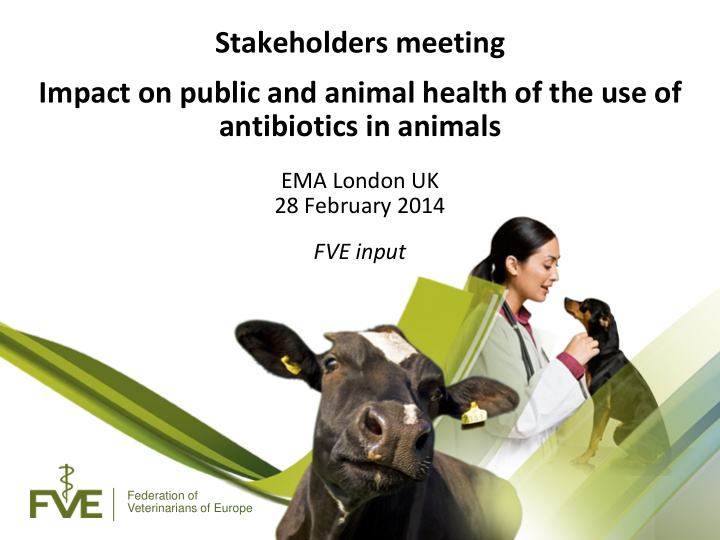



Stakeholders meeting Impact on public and animal health of the use of antibiotics in animals EMA London UK 28 February 2014 FVE input Federation of Veterinarians of Europe
www.fve.org Federation of veterinarians of Europe 46 national associations 38 European countries 4 FVE Sections UEVP ( Practitioners ) UEVH ( Hygienists – Public Health Officers ) EASVO ( Veterinary State Officers ) EVERI ( Education, Research, Industry ) “One Profession-One Vision -One Voice” Federation of Veterinarians of Europe
www.fve.org Our mission “The European veterinary profession, embodied by FVE, strives to promote animal health , animal welfare and public health across Europe . Together with its members, FVE aims to support veterinarians in delivering their professional responsibilities at the best possible level, recognized and valued by society.” Federation of Veterinarians of Europe
www.fve.org Objectives Ensure a sustainable availability of effective antimicrobials for veterinarians Develop new classes of antimicrobials Promote and enforce responsible use of medicines Measure and Monitor consumption Decision making based on science Federation of Veterinarians of Europe
www.fve.org Think ‘One Health’ Human – Animal – Ecosystem interface Ensure any measures to be taken are proportionate and equally applied. Federation of Veterinarians of Europe
Key values www.fve.org Responsible use Categorization of antibiotics Ranking/Classification must not unduly restrict the antimicrobials available for treatment in animals Classifying simply based on the use in human medicine fails to address the importance of these products in veterinary sector CIAs only as last resort and always following AST Success value: ‘One Health’ Rules should apply in both medical and veterinary field Decrease of AMR in humans and animals Federation of Veterinarians of Europe
Consider www.fve.org Animals get also sick and need treatment Failure to treat a disease in animals may have serious consequences to the health and welfare of humans and animals What will be the impact on AMR of CIA restriction to humans only? Successful treatment of an infection in animals will kill the bacteria and stop the spread of disease Extensive restriction on access to new antibiotics may lead to overreliance on older products and rise in resistance Increase in resistance to human enteric bacteria evident in some European countries despite restrictions on the use of newer classes in animals Federation of Veterinarians of Europe
www.fve.org Cascade: Can we afford not having it? • The ‘Safety net’ for small markets / countries and MUMS • Industry is not interested in investing in MUMS products • Increasing availability will greatly decrease off-label use, but still has to be in place, e.g. aquaculture Cascade should be in place and off label use should be monitored Federation of Veterinarians of Europe
More emphasis on: www.fve.org • One true European market for veterinary medicines • Development of faster , cheaper and higher quality ASTs • Promoting responsible use practices, i.e. improving animal husbandry, biosecurity, feed and stockmanship (e.g. FVE leaflets, EPRUMA) • Development of alternatives , e.g. vaccination • Do not forget the risks posed by movement of animals, humans and animal products from/to third countries. Support other regions of the world to also use antibiotics responsibly. • Educate all health professionals through a ‘One Health’ approach Federation of Veterinarians of Europe
www.fve.org Summarizing YES Categorisation of antibiotics NO Restriction of CIAs for human use only YES MA for CIAs in animals YES More Alternatives available in veterinary practice (Vaccines, ASTs, Cascade) Federation of Veterinarians of Europe
www.fve.org FVE-CPME ‘One Health’ Conference Ensuring Health & Sustainability in Europe: Doctors and Veterinarians emphasize “prevention is better than cure” Brussels, 7 April 2014 Thank you for your attention Federation of Veterinarians of Europe
Recommend
More recommend